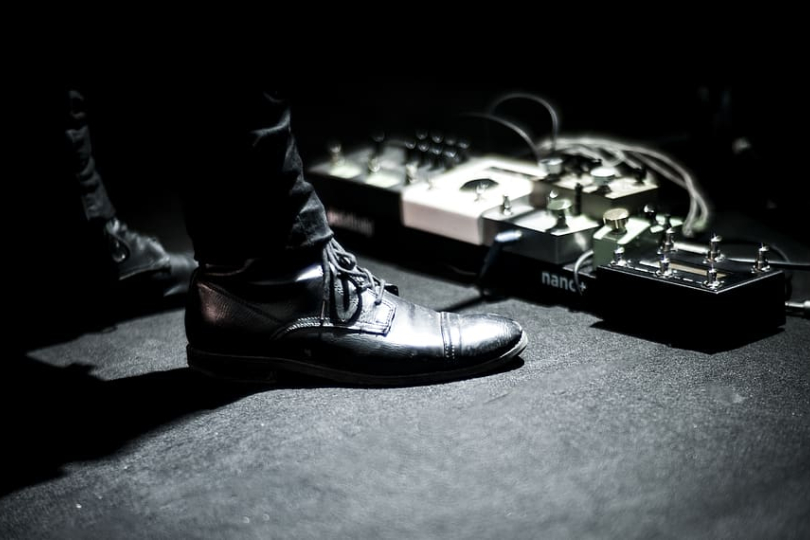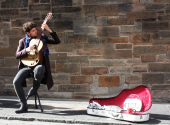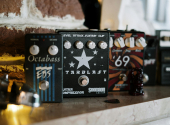
The Guitarist's Survival Guide: Getting Started with Effects Pedals (Part 2)
In the last article, we explored the basics of guitar effects, including EQ pedals, wahs, envelope filters, compressors, volume pedals, and drive pedals like overdrives and distortions. This time, we’ll dive into modulation and time-based effects, which can range from the subtle and tasteful to the weird and wacky. While by no means an exhaustive guide, this article will introduce you to a few key types of pedals that are undoubtedly tremendous fun. Let’s crack on!
Delay pedals
Delay pedals add an echo to your sound, with controls to adjust the number of repeats and their volume. A single, short repeat creates a slapback effect, commonly heard in country and rockabilly music. On the other hand, a series of longer repeats that fade out gradually can produce a lush, atmospheric soundscape. As with most things in the world of guitar, your choice ultimately depends on personal taste. However, delay pedals can generally be categorised into the following types.
1. Tape Delay
Tape delay, also known as tape echo, was originally created using magnetic tape to record and play back sound. Its repeats have a warm, natural tone and gradually lose clarity over time, mimicking the wear of old tape. The repeats can also be slightly unpredictable, adding “warble” or "flutter", adding a unique, vintage character to your guitar playing.
2. Analog Delay
Analog delay pedals create warm, organic repeats that gradually change in tone and clarity over time, getting darker and darker.
What's the difference?
Both tape and analog delays feature repeats that degrade over time, becoming darker, grittier, and more "smeared." Tape delays also exhibit unique modulation (wow & flutter) to simulate tape movement.
3. Digital Delay
Digital delays repeat your sound exactly, without losing quality. You can choose how many repeats you want, and they will stay clear and precise. The main benefit is the clean, consistent repeats, and some digital delays also let you create effects like ducking or dynamic delays.
Why would you choose one over the other?
Again, It all comes down to personal preference. If you're in a larger band with lots of layers, you might prefer the clear repeats of a digital delay, so you don’t have to compete for sonic space. On the other hand, if you have more room to fill and want a more textured vibe, maybe a tape or analog-style could be your bag, baby.
Strymon El Capistan V2
Reverb
Reverb is an effect that makes it sound like you're playing in a large space, such as a big room or cathedral. Instead of hearing separate repeats, you hear one long, blended sound as it bounces around the space. There are various types of reverb, each with different levels of complexity. Many amps have spring reverb, which uses a small spring inside a box that vibrates – this gives a classic 1960s guitar sound. Other types of reverb simulate different spaces, including:
- Plate Reverb: Creates a bright, smooth sound, producing a shiny, dense echo.
- Hall Reverb: Makes it feel like you're in a large concert hall, with deep, long echoes that make your sound feel big and spacious.
- Room Reverb: Simulates a small space, like a room or studio. The echoes are shorter and more natural, giving a more subtle, close-up feel.
Each reverb type changes how your sound fills the space, from bright and dense (plate) to big and expansive (hall) to subtle and intimate (room).
Reverb is an essential effect in the music I play. Whether it's for creating large, lush soundscapes or the intimate feel of a short room reverb, it really makes the guitar come alive. Without reverb, the guitar just feels too dry to me, but that’s my preference. Plenty of players enjoy a tone that’s as dry as bone! It all depends on what (and how) you play.
Tc Electronic Hall of Fame
Modulation
Modulation effects, like vibrato, phasers, flangers, chorus, tremolo, and vibe pedals, add movement and texture to your tone, from subtle shifts to intense sounds. They work by splitting the guitar signal, delaying one part, and altering it before blending it back with the original. Instead of delving into the technical details, I think it's more helpful to share examples of songs or artists that use them effectively!
1. Vibrato
A vibrato pedal adjusts a note's pitch up and down, similar to finger or tremolo arm vibrato. At extreme settings, it can sound out of tune, but at milder settings, it creates a warm, pleasant effect.
Madison Cunningham is the name of the game in vibrato sounds at the moment.
JHS Emperor
2. Chorus
Chorus happens when the vibrato effect is blended back into the original signal, creating a watery sound that adds depth and texture, making clean guitar tones more interesting.
Example: Metallica’s "One" and The Police’s "Walking on the Moon".
Walrus Audio Julia
3. Phaser
A phaser effect, often called "the sound of the 70s," creates a sweeping, "spacey" sound by shifting the phase of the guitar signal and blending it with the original, creating a moving, fluid texture. It’s widely used in funk, reggae, psychedelic, and rock music.
Example: "Breathe" by Pink Floyd is a famous use of the phaser effect.
MXR Phase-90
4. Flanger
A flanger creates a swooshing, jet-like sound by mixing a delayed version of the guitar signal with the original. The delay time is changed slightly, which creates a deep, metallic sound. Compared to a phaser, which has a smoother, sweeping effect, a flanger has a more dramatic, intense sound.
Example: "Barracuda" by Heart is an iconic flanger guitar song.
Fender Hammertone
5. Tremolo
A tremolo effect modulates the volume of the guitar signal, creating a rhythmic pulsing or "shimmering" effect. The volume rises and falls in a regular pattern, adding movement to the sound. Unlike vibrato, which changes pitch, tremolo only affects volume.
Note: You're on firm ground if you find it confusing that a tremolo arm on a guitar changes pitch, but a tremolo pedal alters volume. We can thank Leo Fender for this, but these terms are here to stay, so we’ll just have to live with them.
Example: If phaser was "the sound of the 70s," then tremolo was definitely "the sound of the 60s". Songs like "Bang Bang (My Baby Shot Me Down)" have that classic tremolo sound baked in. Instant vibe.
Tc Electronic Pipeline
A univibe pedal creates a swirling, wobbling sound that’s a mix of chorus and vibrato. It gives your guitar a thick, dreamy feel, almost like the sound is moving through the air. The effect makes your tone feel alive, with a sweeping, psychedelic quality that can be smooth or a bit more intense depending on the settings.
Look, I told you sounds are hard to explain with words. If only there was a famous guitarist who championed the sound of the univibe… oh wait there is one. The guitarist!
Example: Mr. Jimi Hendrix was an avid user of the univibe, and it featured heavily on songs like "Machine Gun" and subtly on songs like "Little Wing".
MXR M68 Uni-Vibe Chorus/Vibrato
Mono/ Stereo
Running in stereo adds an extra dimension to your sound, with subtle differences in time or fluctuation between the left and right channels, making it enjoyable to listen to. Some people appreciate the added spatial control, while others don’t find it worth the hassle. Personally, I enjoy it immensely.
This has been an introduction to guitar effects. In many ways, I’ve only scratched the surface, and there’s much more to explore when it comes to the options available to us as guitarists. Jimi Hendrix and The Beatles were key pioneers of guitar effects, shaping both studio recordings and live performances. Hendrix, especially, experimented with various effects like the Univibe pedal, which helped create his signature psychedelic sound. The Beatles also explored effects in their later albums, using techniques such as the Leslie speaker to add a rotating, dynamic sound to tracks like "Tomorrow Never Knows."
In 2025, these effects will be available in increasingly smaller footprints, packed into increasingly powerful multi-effects units, and who knows what groundbreaking sounds lie ahead.
If you experiment, you may find a combination of sounds, or altogether new sound that changes the way we use effects today. Or you may just end up twiddling the feedback knobs on your delay pedal until it goes "wooooooooosssshhhhhhhh" like I do, and that’s a decent way to spend an evening too.
If you have found an error or typo in the article, please let us know by e-mail info@insounder.org.




